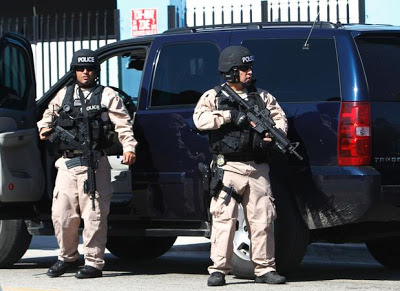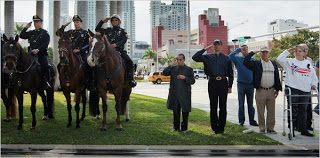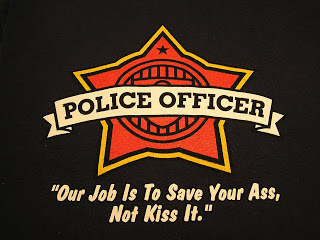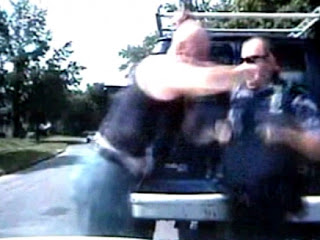Wednesday, January 26, 2011
About that “War on Cops”….
 |
| The War on the Streets: This is Miami, not Mogadishu. |
What would things have been like if every Security operative, when he went out at night to make an arrest, had been uncertain whether he would return alive?…. The [Security] Organs would very quickly have suffered a shortage of officers … and, notwithstanding all of Stalin’s thirst, the cursed machine would have ground to a halt!”–
Alexandr Solzhenitsyn’s famous jeremiad about the passivity of Soviet subjects in the face of the Regime’s armed enforcement agencies.
The grim but statistically inescapable fact is that the average American is much more likely to be killed by a cop than by a terrorist.
Those who publicize police abuses are routinely accused by apologists for government enforcement agencies of exaggerating the problem by focusing on a vanishingly small number of “exceptional” cases. When police are on the receiving end of criminal violence, however, those same apologists demand that we allow such exceptions to define the rule.
On the basis of recent trends, we can assume that two dozen or more Americans have been shot by police since January 1, 2011. In the same period, roughly half that many police have been shot, 11 of them either injured or killed during one unusually bloody twenty-four-hour period. This unconnected series of shootings has led many police officers to believe that they are targets in a “war on cops,” and that alarmist impression has been diligently propagated by police union officials who are always eager to exaggerate the very modest dangers of their profession.

“It’s not a fluke,” insists Richard Roberts, spokesman for the International Union of Police Associations. “There’s a perception among officers in the field that there’s a war on cops going on.” Craig W. Floyd of the National Law Enforcement Officers Memorial Fund described a “very troubling trend” of “officers … being put at greater risk than ever before.”
Actually, where the risk of death on the job is concerned, law enforcement doesn’t crack the top ten list of most dangerous occupations, as designated by the Bureau of Labor Statistics. In fact, none of the jobs on that list involves people employed in the coercive sector. Commercial fishermen, loggers, commercial pilots, farmers, and roofers all face a higher risk of work-related death than that confronted by the State’s armed enforcers, for whom “officer safety” is job one.
Sheriff Smith, like others retailing the “war on cops” meme, recited the durable canard that police “work” is more dangerous today because they confront a more violent breed of street criminal. Five years ago, Joseph McNamara of Stanford’s Hoover Institution, a former NYPD Deputy Inspector (and, unfortunately, an advocate of civilian disarmament), pointed out that police “work” may be safer now than ever before.
In 2005, McNamara noted, fifty-one officers died in the line of duty “out of some 700,000 to 800,000 American cops. That is far fewer than the police fatalities occurring when I patrolled New York’s highest crime precincts, when the total number of cops in the country was half that of today.”
Yes, there is a war on the streets of America, McNamara allowed, but it is one waged by the cops, not on them:

A large and growing segment of the public likewise has become palpably disgusted with the casual elitism of the armed tax-feeders among us, who see themselves as a caste apart from, and superior to, those from whom they extract their livelihood. The police unions and media organs that take dictation from them insist that the purported “war on cops” is being fueled by a growing public “disrespect” for the “authority” of police.
“The palm-sized shield worn on a police officer’s chest should be viewed as a badge of honor, not a bull’s-eye,” sobbed the editorial collective of the Wilkes-Barre Times-Leader in a lachrymose house editorial that typifies media treatment of the supposed “war” on police. “Sadly, recent deadly shootings around the nation and alleged threats directed at Luzerne County law enforcers reveal a troubling lack of respect for officers’ authority and responsibilities, as well as their lives.”
Although Steve Groeninger, spokesman for the D.C.-based National Law Enforcement Officers Memorial Fund, admits that “we don’t have any data,” he told MSNBC that “there seems to be a type of criminal out there looking to thwart authority” (by which he means any directive issued by an armed government functionary) and warns that “cuts in police budgets could exacerbate the danger,” according to MSNBC.
This is an interesting variation on a familiar police union theme. As previously noted in this space, as municipal budgets shrink amid the ever-deepening depression, some police unions are literally trying to terrorize the public into supporting their budget demands. Oakland Police Chief Anthony Batts announced several months ago that because of budget cuts citizens shouldn’t expect police to respond to calls involving 44 kinds of crime, including burglary, grand theft, and other serious offenses. The hideously corrupt Camden, New Jersey Police Department adopted a similar policy after half the force was laid off. In Sacramento County, the Sheriff’s Office published an ad depicting what appeared to be a sexual assault on a child. “Don’t let them cut deputies and put your family at risk!” screamed the ad copy.
Reduced to its essence, the message here is this: Give us what we want, or people will get hurt. Those of us who oppose the demands of police unions can now expect to be told that we’re morally indistinguishable from cop-killers.

Every traffic stop, we are told, is pregnant with potentially lethal danger — for the one party in that confrontation we know to be armed and invested with the supposed authority to kill another human being. In fact, encounters of this kind are freighted with peril for the member of the productive population who has come under the unwanted scrutiny of an armed emissary of the State. This is true of any interaction between the police and the private citizens on whom they subsist.
One likely product of the ongoing panic over a “war on cops” is the increased likelihood that police will resort to potentially lethal force in such routine encounters. After all, isn’t it better to have the taxpayers absorb the cost of settling with the family of a murdered Mundane than to suffer the uniquely poignant anguish of burying one of the State’s Anointed Ones?
Most of the potentially dangerous encounters between police and the public grow out of their roles as enforcers of drug prohibition and armed revenue collectors (those roles overlap, of course). Those dangers will grow more acute as the economy continues to sicken and people who have done no harm to others start to lose patience with the demands of the wealth-devouring class.
Rather than abating their demands and ratcheting down the conflict, however, those in charge of the State clearly intend to escalate it, making whatever use they deem necessary of all of the charming instruments of regimentation and mass violence originally developed for use overseas. One particularly unsettling illustration of this principle is the expanding domestic use of unmanned surveillance drones, which were originally developed for battlefield applications but will probably become as commonplace as SWAT teams within the next several years.
If they have it, they will use it; if it’s been deployed by the military abroad, it will be employed by the paramilitary police at home; once it’s been tested against criminal suspects, it will become part of the standard arsenal of social regimentation. At this point it appears that the only thing that will cause the machinery of repression to grind to a stop would be a fully realized economic collapse. Another grim possibility is that the State’s relentless persecution of harmless people will grow so vicious that the “war on cops” being spoken of now becomes a self-fulfilling prophecy — thereby creating a personnel shortage of the kind Solzhenitsyn described.
Anybody who takes the life of any human being through aggressive violence is a murderer and should be treated as such. That being said, this should be also: If the wildly exaggerated fear of being killed on the job results in increased attrition from the ranks of the State’s armed enforcers, one happy result will be a net decrease in the amount of criminal violence afflicting our society.
Dum spiro, pugno!
Content retrieved from: http://freedominourtime.blogspot.com/2011/01/about-that-war-on-cops.html.



